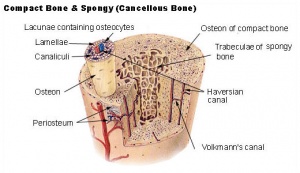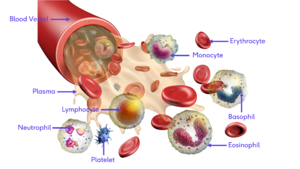Extracellular Matrix: Difference between revisions
No edit summary |
No edit summary |
||
| Line 13: | Line 13: | ||
# Space filling molecules (e.g. [[proteoglycans]], glycosaminoglycans)<ref>Biology on line Extracellular matrix Available: https://www.biologyonline.com/dictionary/extracellular-matrix (accessed 28.6.22)</ref> | # Space filling molecules (e.g. [[proteoglycans]], glycosaminoglycans)<ref>Biology on line Extracellular matrix Available: https://www.biologyonline.com/dictionary/extracellular-matrix (accessed 28.6.22)</ref> | ||
== | == Varies Roles of ECM == | ||
The role of the ECM depends on its nature and composition. eg, the matrix may be mineralised in bone to resist compression or dominated by tension resisting collagen fibres in tendon. Below various examples are given. | The role of the ECM depends on its nature and composition. eg, the matrix may be mineralised in bone to resist compression or dominated by tension resisting collagen fibres in tendon. Below various examples are given. | ||
| Line 28: | Line 28: | ||
== Bone == | == Bone == | ||
[[File:Bone 2.jpg|right|frameless]] | |||
Osteoblasts synthesise bone extracellular matrix. Consists of: | Osteoblasts synthesise bone extracellular matrix. Consists of: | ||
| Line 34: | Line 35: | ||
== Blood == | == Blood == | ||
[[File:Blood with description.png|right|frameless]] | |||
The extracellular matrix of blood is called plasma, making blood unique among connective tissues because it is fluid. This fluid, which is mostly water, suspends the formed elements and enables them to circulate throughout the body within the cardiovascular system. | The extracellular matrix of blood is called plasma, making blood unique among connective tissues because it is fluid. This fluid, which is mostly water, suspends the formed elements and enables them to circulate throughout the body within the cardiovascular system. | ||
== Nervous Tissue == | == Nervous Tissue == | ||
[[File:Glial cells.png|thumb|Glial cells]] | |||
Macroglia mainly provide the the ECM in the nervous system, and is an important source of supporting and signaling. ECM components are key mediators of glial activation and have the capacity to evoke both regenerative and degenerative effects on glia and neurons, The production of ECM components changes drastically during reactive gliosis, a reaction that happens in response to nervous tissue damage. There is little amount of extracellular matrix in the nervous tissue.<ref>Elena Vecino and Jessica C. F. Kwok The Extracellular Matrix in the Nervous System: The Good and the Bad Aspects Available:https://www.intechopen.com/chapters/50300 (accessed 28.6.2022)</ref> | Macroglia mainly provide the the ECM in the nervous system, and is an important source of supporting and signaling. ECM components are key mediators of glial activation and have the capacity to evoke both regenerative and degenerative effects on glia and neurons, The production of ECM components changes drastically during reactive gliosis, a reaction that happens in response to nervous tissue damage. There is little amount of extracellular matrix in the nervous tissue.<ref>Elena Vecino and Jessica C. F. Kwok The Extracellular Matrix in the Nervous System: The Good and the Bad Aspects Available:https://www.intechopen.com/chapters/50300 (accessed 28.6.2022)</ref> | ||
Revision as of 06:11, 28 June 2022
Original Editor - Lucinda hampton
Top Contributors - Lucinda hampton and Tolulope Adeniji
Introduction[edit | edit source]
The extracellular matrix (ECM) is the non-cellular component present within all tissues and organs, providing the essential physical scaffolding for the cellular constituents. The ECM holds water, ensures suitable hydration of the tissue, participates in a selective barrier to the external environment and also gives eg tensile strength, limits overstretch of the organs The ECM also initiates crucial biochemical and biomechanical cues for tissue morphogenesis, differentiation and homeostasis[1][2].
In human, the main components of the extracellular matrix are:
- Fibrous elements (e.g. collagen, elastin, reticulin),
- Link proteins (e.g. fibronectin, laminin), and
- Space filling molecules (e.g. proteoglycans, glycosaminoglycans)[3]
Varies Roles of ECM[edit | edit source]
The role of the ECM depends on its nature and composition. eg, the matrix may be mineralised in bone to resist compression or dominated by tension resisting collagen fibres in tendon. Below various examples are given.
Tendon[edit | edit source]
The ECM of tendon is composed predominantly of collagen, which accounts for ~ 60–85% of the dry weight of the tissue. Approximately 95% of the collagen is type I. The collagen provides excellent mechanical strength to the tendon along one axis! allowing them to be able to withstand tension.[4]
Cartilage[edit | edit source]
Chondrocytes synthesise the cartilage extracellular matrix, making it both stiff and elastic.
- Mainly composed of type II collagen, up to 25 % of dry weight, with types IX and XI collagens present in lower proportions.
- The second most abundant molecules are glycosaminoglycans, such as hyaluronan and aggrecan, which join together to form macromolecular complexes.
Collagen counteracts tensile loads and glycosaminoglycans decrease the mechanical pressures.
Bone[edit | edit source]
Osteoblasts synthesise bone extracellular matrix. Consists of:
- Type I collagen mixed with a matrix of calcium phosphate crystal (which is up to 70 % of the dry weight). Collagen allows bone to be elastic enough to avoid bone fragility and not to be easily broken whilst calcium phosphate crystal provides stiffness and hardness.
- Proteoglcans and glycoproteins, which are less abundant, but vital for the organization of collagen fibers, mineralization and resorption of bone. Chondroitin sulfate accounts for 67-97 % of the bone glycosaminoglycans.[5]
Blood[edit | edit source]
The extracellular matrix of blood is called plasma, making blood unique among connective tissues because it is fluid. This fluid, which is mostly water, suspends the formed elements and enables them to circulate throughout the body within the cardiovascular system.
Nervous Tissue[edit | edit source]
Macroglia mainly provide the the ECM in the nervous system, and is an important source of supporting and signaling. ECM components are key mediators of glial activation and have the capacity to evoke both regenerative and degenerative effects on glia and neurons, The production of ECM components changes drastically during reactive gliosis, a reaction that happens in response to nervous tissue damage. There is little amount of extracellular matrix in the nervous tissue.[6]
Sub Heading 3[edit | edit source]
Resources[edit | edit source]
- bulleted list
- x
or
- numbered list
- x
References[edit | edit source]
- ↑ Simona Pompili, Giovanni Latella, Eugenio Gaudio, Roberta Sferraand Antonella Vetuschi The Charming World of the Extracellular Matrix: A Dynamic and Protective Network of the Intestinal Wall Available: https://www.frontiersin.org/articles/10.3389/fmed.2021.610189/full (accessed 28.6.2022)
- ↑ Christian Frantz,Kathleen M. Stewart,Valerie M. Weaver The extracellular matrix at a glance Available: https://journals.biologists.com/jcs/article/123/24/4195/31378/The-extracellular-matrix-at-a-glance (accessed 28.7.2022)
- ↑ Biology on line Extracellular matrix Available: https://www.biologyonline.com/dictionary/extracellular-matrix (accessed 28.6.22)
- ↑ H.R.C. Screen, D.E. Birk, [...], and M.F. Young Tendon Functional Extracellular Matrix Available: https://www.ncbi.nlm.nih.gov/pmc/articles/PMC4507431/ (accessed 28.6.2022)
- ↑ Mmegias ECM Available: https://mmegias.webs.uvigo.es/02-english/5-celulas/2-tipos_mat_met.php (accessed 28.6.2022)
- ↑ Elena Vecino and Jessica C. F. Kwok The Extracellular Matrix in the Nervous System: The Good and the Bad Aspects Available:https://www.intechopen.com/chapters/50300 (accessed 28.6.2022)









